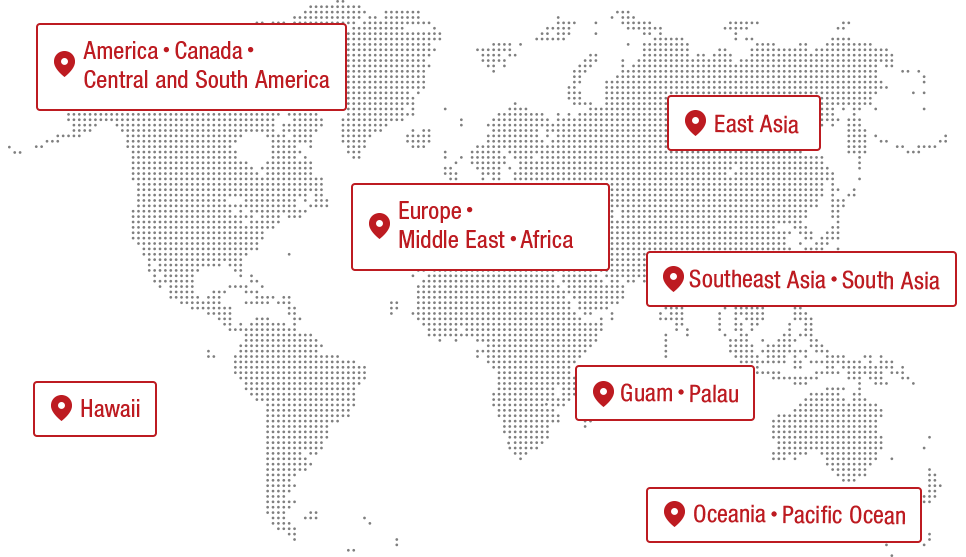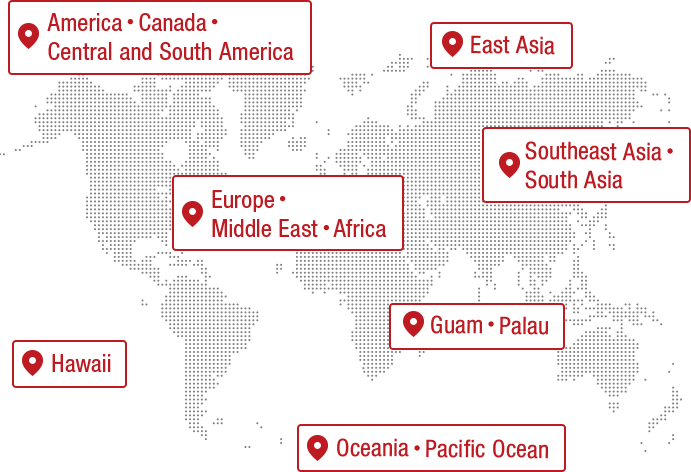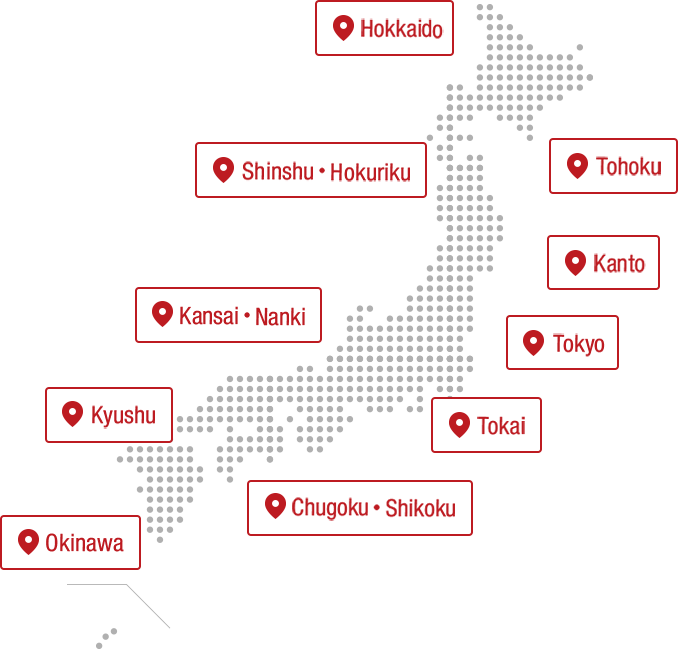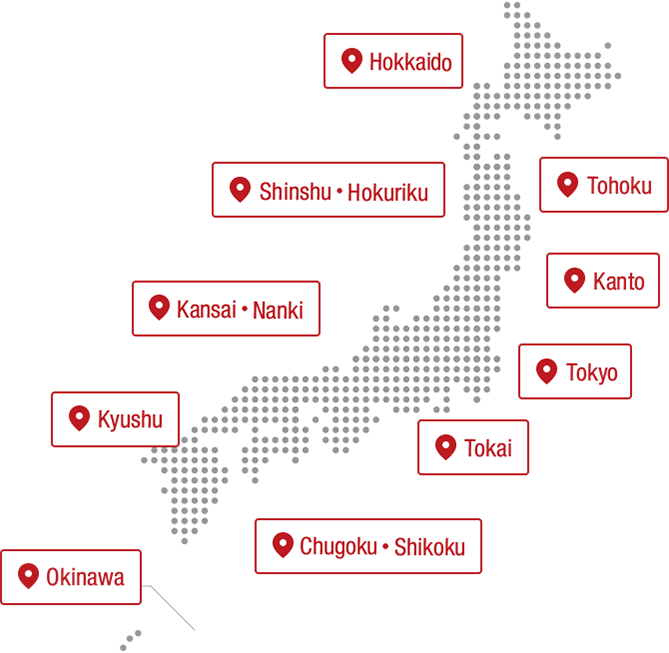Nagasaki has seen many historical "firsts in Japan". These events continue to this day. In this article, we will introduce a two-day, one-night model itinerary that will take you around the city of Nagasaki, from classic tourist spots to the latest hotspots. We will bring you the current state of this historic international city, which is fun to visit no matter how many times you visit.
*Prices include tax.
INDEX
- Day 1: Experience the old and new sides of Nagasaki
- Take a stroll through the "Dejima" area, where you can feel the history of Nagasaki
- Enjoy the famous champon at Kyokaen, located at the entrance to Chinatown
- Latest! Nagasaki Stadium City is packed with "Japan firsts"
- Admire the view from Mount Inasa, known as the "10 million dollar night view"
- Enjoy local fish at Kaneman, a traditional Japanese restaurant in the inner sanctum of Nagasaki
- Visit Kaniya, the famous onigiri shop that Nagasaki locals visit for the final meal
- Day 2: Digging deeper into the culture and romance of an international city
- Take a stroll through a town rich in history and friendly people
- Enjoy Nagasaki delicacies such as Shippoku cuisine at a long-established restaurant
- "Gunkanjima" - a moving site where traces of the passion and lives of our ancestors are visible
- Search for souvenirs at Nagasaki Kaido Kamome Market, where famous products from all over the prefecture are available!
- A journey to discover the new Nagasaki
Day 1: Experience the old and new sides of Nagasaki
On the first day, we'll start at the "Dejima" area, which once flourished as a trading post. We'll then go to the new and popular "Nagasaki Stadium City" and then visit the nighttime attractions such as "Mount Inasa."
It takes about 45 minutes by bus from Nagasaki Airport, which is the base of your trip, to Nagasaki Station. You can also get from Fukuoka Airport to Nagasaki Station by Shinkansen from Hakata Station in as little as 90 minutes, so you can combine your trip with a trip to Fukuoka.
Take a stroll through the "Dejima" area, where you can feel the history of Nagasaki

Dejima was built by the Edo Shogunate in 1636 (Kan'ei 13). It was Japan's first fully-fledged artificial island, and played a major role in modernization as the only window to the West during the period of national isolation in Japan. It is about one-third the size of the Tokyo Dome. Development began after the war in the Showa era, but it was not until the Heisei era that it was restored to the point where it could be visited as the "Dejima Dutch Trading Post Ruins."

The island is home to many historical structures, including the Former Dejima Theological Seminary, the oldest surviving Protestant seminary in Japan, which was completed in 1878 (Meiji 11), as well as restored buildings. There is also a "mini-Dejima" exhibit that gives a complete picture of what the island was like in the past.

Many of the buildings are open to the public, and some rooms have been recreated to recreate the interior and usage scenes of the time. For example, the banquet party exhibit features a Christmas menu, making it a valuable resource for learning about the type of Western cuisine that was served in Japan over 100 years ago.

Other attractions at the facility include the Former Nagasaki Naigai Club, a building that was once used as a reception facility and has now been renovated into a restaurant open to the public, a kimono rental shop, and souvenir shops.

If you're visiting Dejima, we also recommend the Nagasaki Dejima Wharf. It is located in the Nagasaki Port Bay Area, across National Route 499 from the site of the Dejima Dutch Trading Post. This is a commercial complex that opened in 2000 to commemorate the 400th anniversary of Japan-Holland relations.
Not only can you enjoy an open view, but it is also lit up at night, creating a luxurious atmosphere. There are also stylish cafes and restaurants lined up, so be sure to stop by.
Dejima Dutch Trading Post Site
| address | : | Nagasaki Prefecture, Nagasaki City, Dejimamachi 6-1 |
|---|---|---|
| phone | : | 095-821-7200(出島総合案内所) |
| Opening times | : | 8:00-21:00 (last entrance 20:40) |
| Closed Day | : | none |
| Admission fee | : | Adults 520 yen / High school students 200 yen / Elementary and junior high school students 100 yen |
| web | : | Dejima official website |
Nagasaki Dejima Wharf
| address | : | Nagasaki Prefecture, Nagasaki City, Dejimamachi 1-1 |
|---|---|---|
| web | : | Nagasaki Dejima Wharf Official Website |
Enjoy the famous champon at Kyokaen, located at the entrance to Chinatown

Nagasaki Shinchi Chinatown is one of the three biggest Chinatowns in Japan, along with Yokohama Chinatown and Kobe Nankinmachi. Although it is compact, it has a long history dating back to the Edo period, making it older than the other two cities that developed during the Meiji period.

And speaking of Nagasaki's representative local cuisine that shows the influence of Chinese culture, it would be Nagasaki Champon. It is said to have originated at the Chinese restaurant Shikairou, located near the entrance to Glover Garden, but there are many other famous restaurants in the city. In this article, we will introduce Kyokaen, located at the entrance to Nagasaki Shinchi Chinatown.

"Champon" 1,100 yen
Despite its luxurious atmosphere and extensive course menu, the restaurant's prices are reasonable. The specialty "champon" and "sara udon" are 1,100 yen each, and other dishes are also reasonably priced. "Champon" is full of seafood and mountain delicacies in both the ingredients and soup, and the creamy paitan (white broth) has plenty of depth. The medium-thick noodles, with just the right amount of firmness and a chewy texture, go perfectly with the ramen.

"Sara udon" is 1,100 yen each. The noodles in the front are thick, and the noodles in the back are thin.
For those looking for a unique dish, try the "Nira Panmen" (1,100 yen). This is a mixed soba noodle dish made with champon noodles, and the soft and juicy roast pork and the crunchy bean sprouts and chives make for an excellent dish.
Kyokaen
| address | : | Nagasaki Prefecture, Nagasaki City, Shinchimachi 9-7 |
|---|---|---|
| phone | : | 095-821-1507 |
| Opening times | : | 11:00-15:00 (last entry 14:30), 17:00-20:30 (last entry 19:30) |
| Closed Day | : | Irregular holidays |
| web | : | Kyokaen Official Website |
Latest! Nagasaki Stadium City is packed with "Japan firsts"

Next, we will introduce Nagasaki's newest spot, Nagasaki Stadium City. This is a large facility that will open in October 2024, about a 10-minute walk from Nagasaki Station, by the Sasebo-based Japanet Group. It is a large facility that will house an arena, offices, commercial facilities, hotels, and more, with a soccer stadium at its center.

You will be amazed from the moment you step up to the lobby floor. Beyond the windows is a view of the stadium, the first of its kind in Japan, with approximately 20,000 seats. This specification is also available on other floors, such as the food hall, natural hot springs, and pool, and can also be selected for the guest rooms. You can enjoy extraordinary experiences everywhere.

The stadium's seats are located at the shortest distance from the pitch as required by domestic regulations. In other words, it is the closest soccer stadium in Japan to watch the game. In addition, a zip line measuring 60m high and 243m long is installed above the pitch, and can be used without reservation (2,500 yen). Of course, this specification is also a first in Japan.

There are also plenty of dining facilities. For example, there is a store called "Stamina Honpo Kaya" that serves the Sasebo Burger, which is famous for being delicious even in the original place, and "Isoroku" that serves the popular Nagasaki horse mackerel fry, and there are many local gourmet foods from the prefecture. The first of its kind in Japan is the beer brewery inside the soccer stadium.

The name of the shop is "THE STADIUM BREWS NAGASAKI", with a beer restaurant on the second floor and a beer bar on the third floor. They serve freshly brewed craft beer by their brewers. Their specialty beer is "V-Beer", a fruit ale made with Nagasaki's citrus fruit "Yuko". You can enjoy a beer flight of three types with other beers of the day for 800 yen, or 1,100 yen.

Nagasaki Stadium City has many shops and restaurants, as well as many areas that are open to the public, such as parks, and when there are no games or other events, admission to the stadium is free. Feel free to visit this facility that is full of new things.
Nagasaki Stadium City
| address | : | Nagasaki Prefecture, Nagasaki City, Saiwai-cho 7-1 |
|---|---|---|
| phone | : | 0120-101-477 |
| web | : | Nagasaki Stadium City Official Website |
Admire the view from Mount Inasa, known as the "10 million dollar night view"

The view from the top of Mount Inasa in the city is counted among Japan's top three night views, alongside Hakodate and Kobe, and has also been recognized as one of the world's new top three cities for night views, alongside Monaco and Shanghai.

The summit is 333m above sea level, the same height as Tokyo Tower. The area is popularly known as "Inasayama Park," and at the summit you'll find a stylish cylindrical observation deck and a red TV tower. The cityscape, known as the "10 million dollar night view," is a spectacular sight. On a clear day, you can also see as far as Unzen, Amakusa, and the Goto Islands.
Inasayama Park
| address | : | Nagasaki Prefecture, Nagasaki City, Fuchimachi 407-6 |
|---|---|---|
| phone | : | 095-861-7742(公園、スロープカー) |
| Opening times | : | 9:00-22:00 (Slope car, ropeway) |
| Closed Day | : | none |
| web | : | Inasayama Park Official Website |
Enjoy local fish at Kaneman, a traditional Japanese restaurant in the inner sanctum of Nagasaki

About 20 minutes by car from the city center, in the port town of Mogi, also known as the "inner parlor of Nagasaki," is a restaurant called "Ikesu Cuisine Kaneman." Located on the seafront, it is a place where you can enjoy fresh seafood from Tachibana Bay, which spreads out before your eyes.

The specialties are the "Nagasaki Sashimi Assortment" which offers seasonal bounty, "Fried Mogi Shrimp" and "Salt-Grilled Shrimp and Sea Bream". Nagasaki is famous for its fan shrimp, and the traditional food "Hatoshi" is a bread sandwich with shrimp paste, and shrimp is a representative seafood. You can enjoy the deliciousness to the fullest.

If you're going to order alcohol, be sure to try Kyushu's local sake. The lineup includes Hirado's famous sake "Hiran" and Saga's representative brand "Nabeshima," which go perfectly with the food.
Fish pond cuisine Kaneman
| address | : | Nagasaki Prefecture, Nagasaki City, Mogimachi 2190-6 |
|---|---|---|
| phone | : | 095-836-0069 |
| Opening times | : | 11:30-21:30 (last entry 19:00, reservation required) |
| Closed Day | : | Irregular holidays |
| web | : | Fish pond cuisine Kaneman official website |
Visit Kaniya, the famous onigiri shop that Nagasaki locals visit for the final meal

Ramen is the standard way to finish off a night of drinking, but in Nagasaki, onigiri and ojiya are also popular. In particular, Kaniya Doza Honten, famous nationwide for its onigiri, is a famous restaurant founded in 1965 (Showa 40), and the nearest stop is the Kankodori tram stop that runs through the city.

There are over 15 types of onigiri fillings, and they are reasonably priced, starting at 220 yen each. The most popular is "Salted Mackerel" (220 yen), while the most popular ochazuke is "Sake Ochazuke" (600 yen), and the most popular soup is "Akadashi" (330 yen). The shop has a counter at the front and tables and tatami rooms at the back, where a chef will make the onigiri right in front of you.

From the left, "Iwasaki Honpo Collaboration Stewed Pork" (250 yen), "Salted Mackerel" (220 yen)
The noodles are served in a sieve and you can have as much pickled radish as you want. They are a little on the small side and the rice is plump but firm. The combination of the fragrant seaweed and the ingredients is excellent, and it's so delicious you can eat it all up even after drinking. It's a restaurant that seems to exist for the people of Nagasaki Prefecture, and is only open in the evenings, not during the day or on Sundays. That's why it's a restaurant you'll want to visit.
Kaniya Doza Main Branch
| address | : | Nagasaki Prefecture, Nagasaki City, Dozamachi 10-2 |
|---|---|---|
| phone | : | 095-823-4232 |
| Opening times | : | 18:00 to 2:00 the next day, Fridays, Saturdays, and days before holidays 18:00 to 3:00 the next day |
| Closed Day | : | Sundays (open if Monday is a public holiday, closed on Mondays) |
| web | : | Kaniya official website |
Day 2: Digging deeper into the culture and romance of an international city
On the second day, you'll start the day with a stroll around the historic city center, then disembark on Gunkanjima after lunch. There are morning boats to the island, so you can also go there in the morning. Once you've returned, you can look for souvenirs before heading home. Finally, we'll introduce some noteworthy products.
Take a stroll through a town rich in history and friendly people

The upland area of Nagasaki city is Teramachi-dori, where two shrines and 14 temples stand almost in a row. If you go along Ryoma-dori, which connects to the street, you will come to the former site of Kameyama-shachu, a place associated with Sakamoto Ryoma, as well as its memorial hall and exhibition space. In the vicinity, you will also find the birthplace of photographer Ueno Hikoma, who photographed Sakamoto Ryoma, Katsu Kaishu, Ito Hirobumi, and others, and a slope called Hikoma-dori.

One of the famous temples is Higashimyozan Kofuku-ji Temple. This is the temple where Ingen Osho (Ingen Ryuuki), who brought kidney beans, sesame tofu, kenchinjiru (a soup made with soy sauce and soy sauce), as well as vegetables such as lotus root and eggplant, seals, and Ming Dynasty font characters from China, entered.

There are many lively shopping streets close to Teramachi Street, one of which is Nakadori Shopping Street, bustling with old-fashioned shops and new shops renovated from traditional townhouses. If you're looking for a snack, we recommend New York Do, which was founded in 1937 (Showa 12) and serves unique and delicious food.

The specialty is "Castella Ice" (350 yen), which has an evolved taste that is slightly different from the standard castella. The store also sells "Nagasaki Castella Kirihashi" in limited quantities, and customers who purchase it will receive "Funwari Kirihashi" as a service. They also sell frozen souvenirs, so be sure to stop by.

If you walk along the shopping street towards Nagasaki Station and the port for a few minutes, you will come across the Nakajima River. Here you will find the famous "Meganebashi Bridge", the oldest surviving arched stone bridge in Japan. It was built in 1634 during the Edo period. On a sunny day when the water is calm, don't forget to take a commemorative photo.
Toumei-san Kofuku-ji Temple
| address | : | Nagasaki Prefecture, Nagasaki City, Teramachi 4-32 |
|---|---|---|
| phone | : | 095-822-1076 |
| Opening times | : | 8:00~17:00 |
| Closed Day | : | none |
| Admission fee | : | Adults 300 yen / Junior and senior high school students 200 yen / Elementary school students 100 yen |
| web | : | Kofukuji Temple Official Website |
New York Hall
| address | : | Nagasaki Prefecture, Nagasaki City, Furukawa-cho 3-17 |
|---|---|---|
| phone | : | 095-822-4875 |
| Opening times | : | 11:00~16:30 |
| Closed Day | : | Irregular holidays |
| web | : | New York Hall Official Website |
Enjoy Nagasaki delicacies such as Shippoku cuisine at a long-established restaurant

We have mentioned Nagasaki's unique Japanese, Chinese and Dutch culture above, but are you familiar with "shippoku cuisine," a type of Japanese, Chinese and Dutch cuisine? Next, we will introduce Sakamotoya, a traditional Japanese restaurant that was founded in 1894 (Meiji 27) and serves shippoku cuisine.

"Shippoku" refers to a vermilion-painted round table. Food is served on large and small plates for the number of people. Other etiquette includes starting with a bowl, serving standard dishes such as boiled beans and toubani (pork stew), serving with chopsticks, and using two plates instead of exchanging side plates.

The specialty of "Sakamotoya" is Touba-ni, which has a soft, melt-in-your-mouth texture and a sweet, rich flavor. The restaurant also features seasonal dishes on its menu, and in January they serve dishes like osechi ryori (New Year's cuisine), such as Datemaki and Kurikinton. This is a place not to be missed by those who want to taste the luxurious local cuisine that can only be experienced while traveling.
Sakamotoya
| address | : | 2-13 Kanayamachi, Nagasaki City, Nagasaki Prefecture |
|---|---|---|
| phone | : | 0120-26-8210 |
| Opening times | : | 11:30-13:30 (last entry), 17:30-19:30 (last entry) |
| Closed Day | : | none |
| web | : | Sakamotoya official website |
"Gunkanjima" - a moving site where traces of the passion and lives of our ancestors are visible

One of the most famous ruins in Japan is Gunkanjima (Hashima Island). It is located 18.5 km off the coast of Nagasaki Port and is about five times the size of the Tokyo Dome. In 2015, it was registered as a World Heritage Site as one of the constituent assets of the "Meiji Industrial Revolution Heritage Sites: Iron and Steel, Shipbuilding and Coal Mining."

Coal mining began on Gunkanjima around 1810 during the Edo period when coal was discovered. As coal production increased, the population grew, and Japan's first high-rise reinforced concrete apartment building was completed in 1916 (Taisho 5). At its peak in 1960 (Showa 35), the island was bustling with over 5,200 people living there, but as demand shifted from coal to oil, coal production and the population gradually decreased. The mine was closed in 1974 (Showa 49), and the island became uninhabited.

To get to the island, you need to make a reservation in advance and take a cruise ship that departs from Nagasaki Port. However, depending on the weather and high waves, it may not be possible to land on the island or the operation may be canceled. This is at the captain's discretion on the day, and if it is not possible to land on the island, the tour will be changed to a "Gunkanjima Cruise."

The estimated time for the trip varies depending on the operating company and the day, but it is about 45 minutes one way and about 1 hour for landing. The entire cruise is about 2 hours and 30 minutes. On the way to the island, you can also see the Giant Cantilever Crane and Mitsubishi Nagasaki Shipyard, which are also part of the World Heritage Site.

There is a set tour route for the island, but you can learn about the history and surrounding area from the panels and guide's explanations. Even though it is in ruins, it is moving to think that people were living here until about half a century ago. Since Gunkanjima is gradually changing its appearance every year due to typhoons and high tides, and is also affected by the weather, it is best to visit Gunkanjima when you can.
Yamasa Kaiun Gunkanjima Landing Cruise
| address | : | Nagasaki Port Terminal Building, 17-3 Motofunamachi, Nagasaki City, Nagasaki Prefecture |
|---|---|---|
| phone | : | 0800-200-8180 (Reservation) |
| Opening times | : | 8:15-17:00 (reception hours) |
| Closed Day | : | none |
| Fee | : | Junior high school students and above: 4,500 yen (facility tour fee: 310 yen) / elementary school students: 2,250 yen (facility tour fee: 150 yen) |
| web | : | Gunkanjima Landing Cruise Official Website (Yamasa Kaiun website) |
Search for souvenirs at Nagasaki Kaido Kamome Market, where famous products from all over the prefecture are available!

A recommended souvenir spot is the Nagasaki Kaido Kamome Market, located right in front of the JR Nagasaki Station ticket gate. Opened in 2022, it consists of one of the largest souvenir zones in the city and the local gourmet area "Kamome Yokocho." We will introduce some of the most popular items.

While Bunmeido and Fukusaya are famous for their castella cakes, you also can't miss Kinkaido's Nagasaki Wasanbon Castella (from 1,080 yen for 5 slices).

This is a masterpiece that has the rich yet delicate sweetness of wasanbon sugar and allows you to enjoy its refined flavor.

If you're looking for a Nagasaki specialty other than castella, how about Sasebo's proud "Kujukushima Senpei" (8 pieces for 756 yen and up). The flavor and accent of peanuts harmonizes with the gentle sweetness of the dough, creating a sweet and fragrant taste.

There is also a wide lineup of local seasonings such as "Kincho Worcestershire Sauce," known as the absolute champion of udon noodles, and craft gin, which has been gaining attention in recent years. Among them, the craft gin "GOTOGIN" made by a newly established distillery in Goto is very popular among fans of Western liquor. Traditional Iki Shochu is also a famous Nagasaki drink, but this is also recommended as a souvenir for alcohol lovers.

Of the traditional crafts, Hasami ware is extremely popular. If you go to the section that sells it, you'll find works by various potteries and artists, so be sure to stop by.
Kamome Yokocho also has a standing bar with a wide selection of local sake and Iki shochu, making it a convenient place for meetings and breaks. Another appeal of Nagasaki Kaido Kamome Market is its ease of use and usefulness.
Nagasaki Kaido Kamome Market
| address | : | 1-67 Onoecho, Nagasaki City, Nagasaki Prefecture |
|---|---|---|
| phone | : | 095-808-2001 |
| Opening times | : | 8:30-20:00 (souvenirs and merchandise), 11:00-22:00 (local restaurants), 11:00-23:00 (Kamome Yokocho) |
| Closed Day | : | none |
| web | : | Nagasaki Kaido Kamome Market Official Website |
A journey to discover the new Nagasaki
Nagasaki is evolving into a new international tourist city, based on its history and traditions. With popular spots such as Huis Ten Bosch, Shimabara, Unzen, Obama, Hasami, and remote islands, why not take a trip to rediscover the city's charms as it becomes more and more unique?
Related articles
The contents published are accurate at the time of publication and are subject to change.
















